How to Track Keyword Performance and Improve SEO at the Same Time
Hansjan Kamerling
May 12
Why SEO Rank Monitoring Is Essential for Success
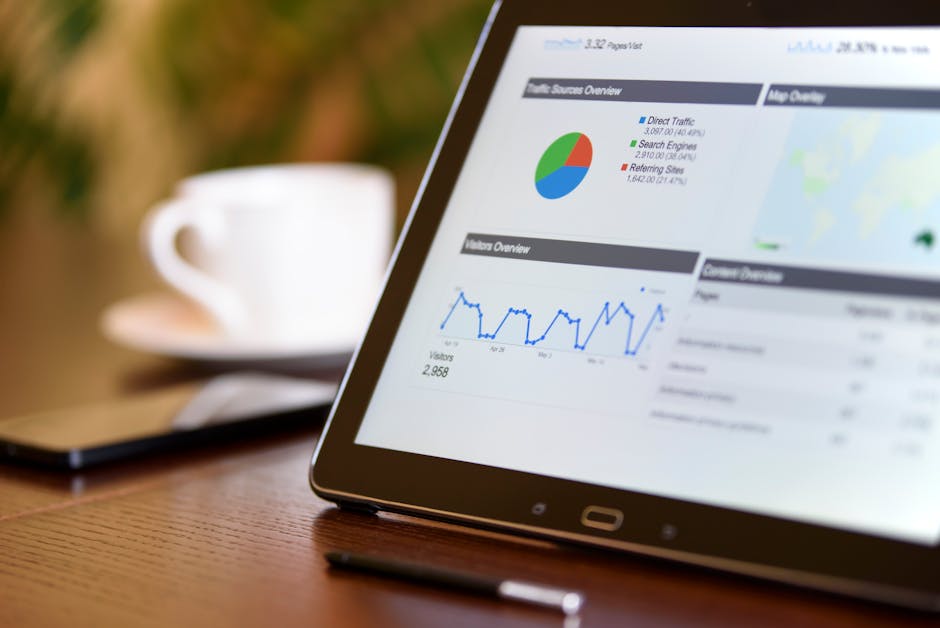
SEO Rank Monitoring is the process of tracking how well your website ranks in search engine results for targeted keywords. To effectively monitor your SEO rankings, follow these steps:
- Choose a reliable rank tracking tool (AWR, Semrush, SE Ranking, or Ahrefs)
- Select relevant keywords to track (including branded, commercial, and informational terms)
- Set up tracking for multiple devices (desktop and mobile)
- Track local rankings if applicable to your business
- Monitor SERP features (featured snippets, local packs, knowledge panels)
- Schedule regular checks (daily, weekly, or monthly depending on your needs)
Without proper rank monitoring, you're essentially operating your SEO strategy blindfolded. Today's digital landscape demands more than occasional manual checks – you need systematic tracking that captures the full picture of your search visibility.
"Ranking position alone is a poor KPI—trend shifts matter more than absolute rank," notes one SEO expert, highlighting that effective monitoring goes beyond simply checking if you're #1 for a keyword.
Proper SEO Rank Monitoring reveals critical insights: which content performs well, where opportunities exist, how algorithm updates affect you, and how you stack up against competitors. It transforms raw data into actionable intelligence that drives your entire SEO strategy.
I'm Hansjan Kamerling, a product design and marketing consultant who has implemented SEO Rank Monitoring systems for numerous startups and enterprises, helping them track performance across millions of keywords and turn ranking data into measurable business growth.
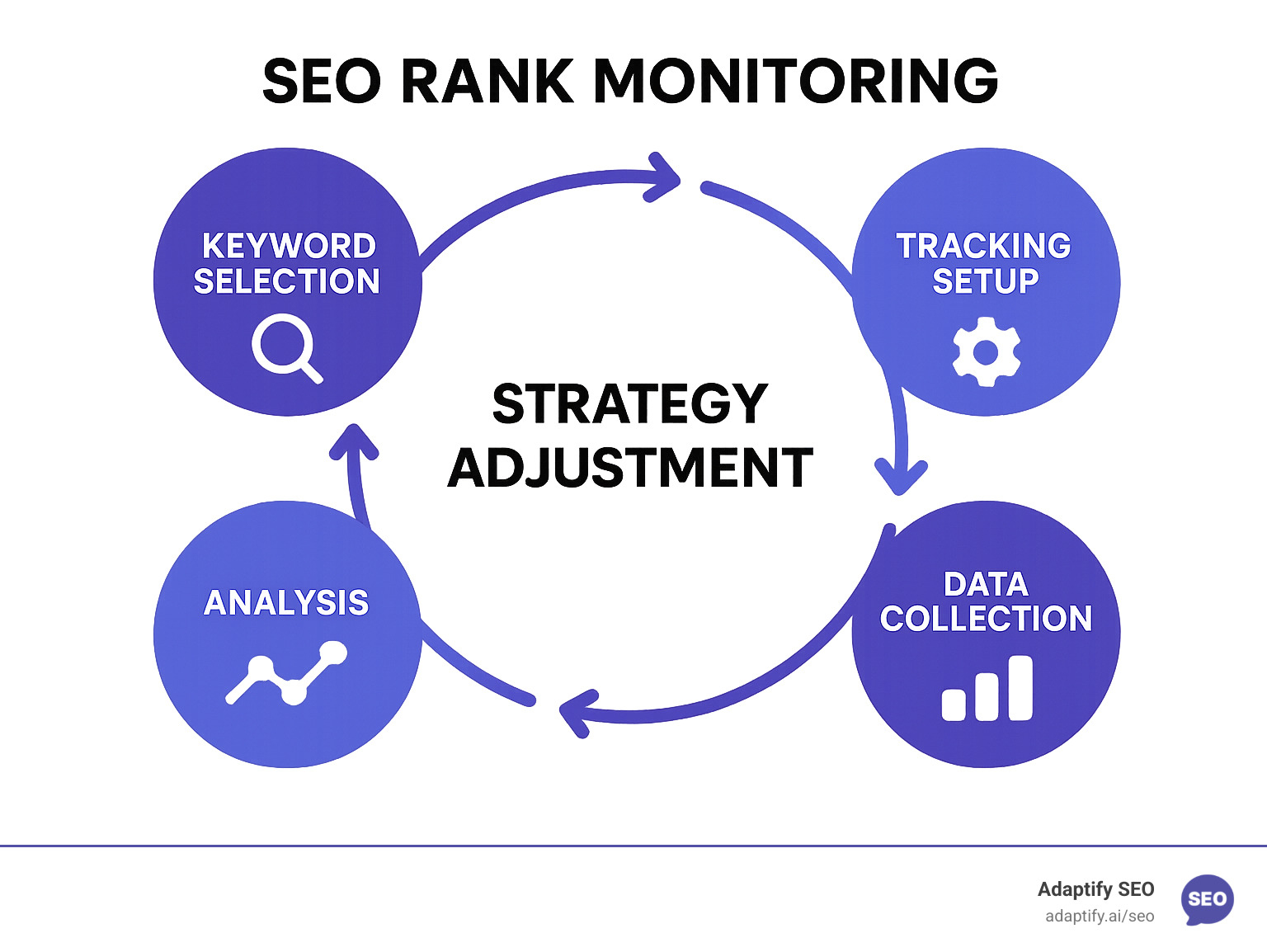
Understanding SEO Rank Monitoring
Let's be honest - tracking where your website shows up in Google isn't as simple as it used to be. SEO Rank Monitoring today is like trying to keep tabs on a shape-shifter that's constantly evolving!
Gone are the days when you could just check if you're #1 for your favorite keyword. The modern search landscape looks more like a busy marketplace than a simple list. Featured snippets grab attention at the top, knowledge panels steal glances from the side, and image carousels, video results, and local packs all compete for those precious clicks.
Think about it - you could technically be in "position 1" but actually appear halfway down the page because of all these SERP features. That's why smart monitoring looks at the whole picture of your visibility.
Google now juggles hundreds of ranking factors when deciding where to place your content. Mobile-friendliness isn't optional anymore - it's essential. Page experience matters tremendously. Content quality remains king. And those user engagement signals? They're like digital applause that Google definitely notices.
Perhaps most important is Google's shift to mobile-first indexing. This means the mobile version of your site now determines your rankings across all devices. Ignore how your site performs on smartphones, and you're essentially sabotaging your desktop rankings too!
What is SEO Rank Monitoring and Why It Matters
At its core, SEO Rank Monitoring is simply keeping track of where your website appears in search results for keywords that matter to your business. But good monitoring goes deeper - checking across different devices, locations, and even search engines.
Why should you care so much about this? Well, the numbers tell a compelling story:
The #1 position in Google typically captures around 28% of all clicks, while position #10 gets a measly 1%. That dramatic drop means sliding from position #3 to #8 isn't just a minor setback - it could mean thousands of visitors who never find you.
But smart businesses don't just track rankings for vanity's sake. By connecting your ranking data with conversion information, you find which keywords actually drive business results, not just traffic. As one agency put it, "We use forecasting to tie SEO efforts directly to traffic and revenue," making the business impact crystal clear.
"Most rank tracking tools are complicated, outdated, and unreliable. What's needed is a user-friendly rank tracking platform that SEO professionals and business owners can easily leverage to track keyword performance data over time," notes a testimonial from Ranktracker's website.
Desktop vs. Mobile vs. Local Rankings
One of the most eye-opening aspects of modern SEO Rank Monitoring is seeing how dramatically rankings can vary depending on where and how someone searches.
Have you ever checked your ranking on your phone and then on your laptop, only to see completely different results? You're not imagining things! With nearly 50% of all website visits now coming from mobile devices, tracking only desktop rankings gives you half the picture at best.
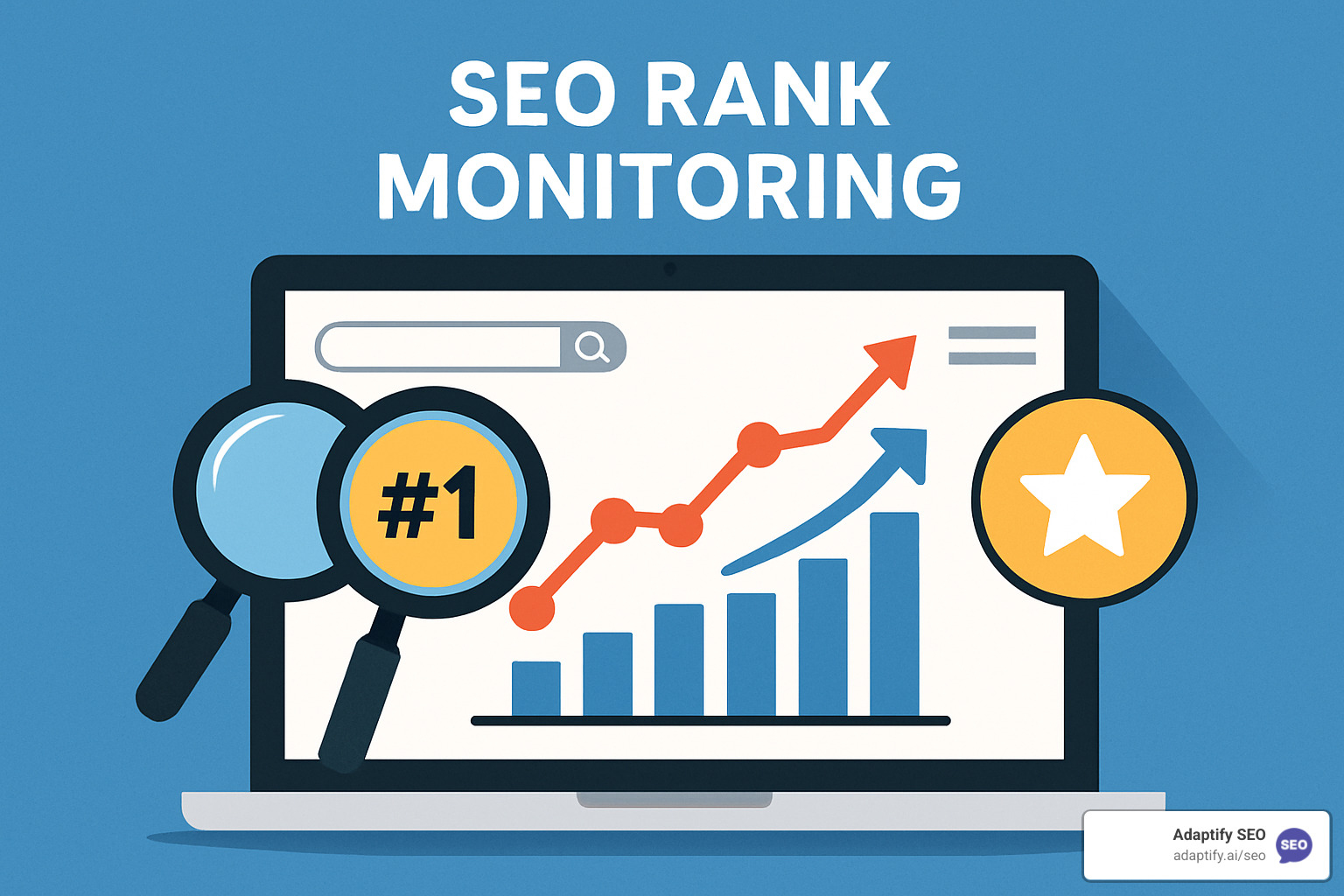
Local rankings add another fascinating layer. If you run a business with physical locations (or one that serves specific areas), the local pack - those map results that appear for location-based searches - can make or break your visibility. For searches like "dentist near me" or "best plumber," the local pack often gets the majority of clicks.
This is why tools like Advanced Web Ranking, which tracks rankings across 4,000 search engines and is trusted by 24,000 companies, offer such granular monitoring options. You can check rankings for specific cities, zip codes, or even precise coordinates on a map.
The geographic differences can be startling - a coffee shop ranking #1 in one neighborhood might be completely invisible just a few miles away. This explains why over 26,815 Google Business Profiles are actively managed with specialized tools like Localo focused specifically on local search visibility.
Setting Up Your Rank Tracking Framework
Setting up an effective SEO Rank Monitoring framework isn't just about tracking a bunch of keywords—it's about creating a thoughtful system that delivers actionable insights. Think of it as building your SEO command center where all the important data flows in at just the right time.
When I help clients set up their tracking systems, I always start with comprehensive keyword research. Your tracking should include a healthy mix of terms that actually matter to your business:
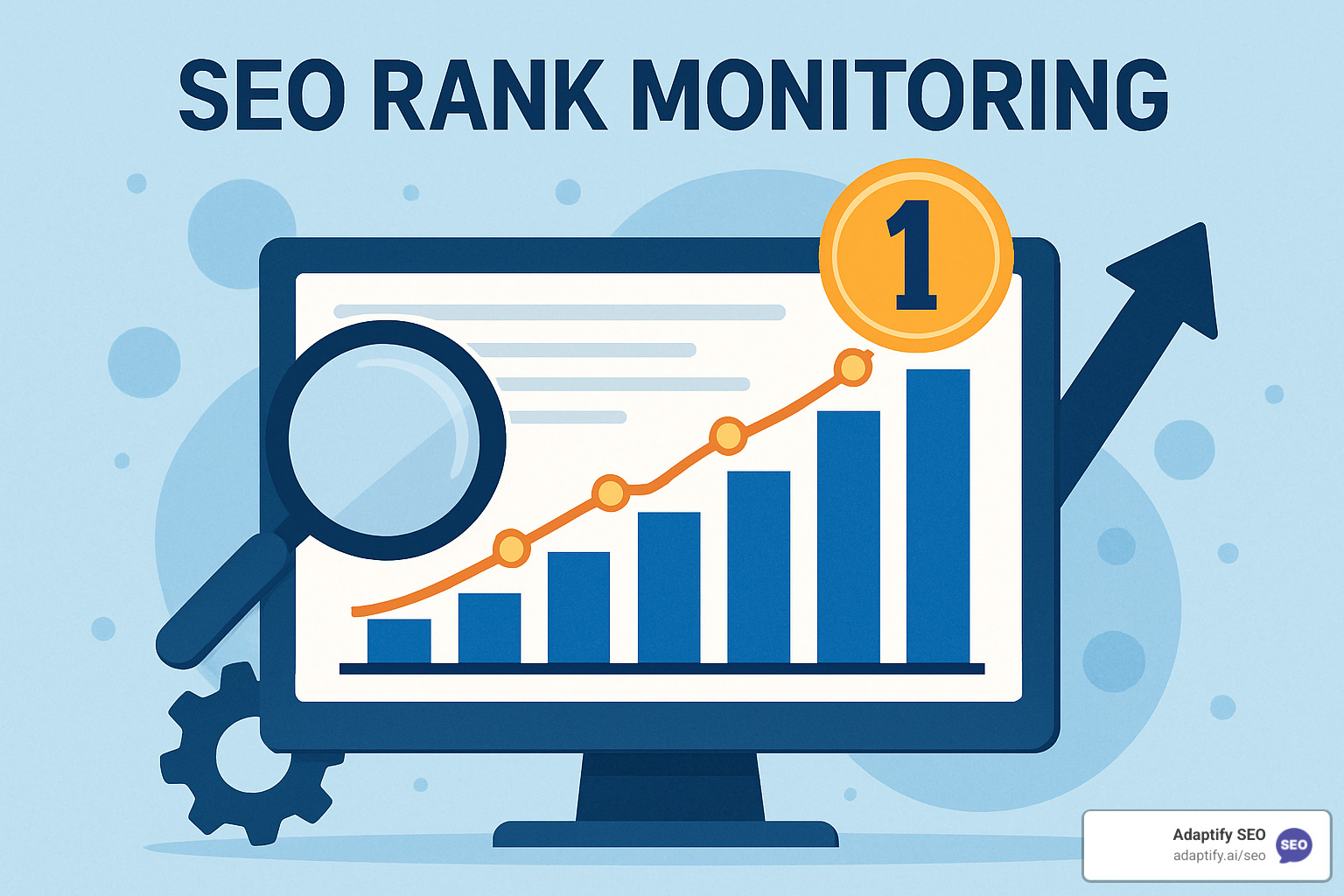
The secret sauce is in how you organize these keywords. A smart tagging system—grouping terms by product line, customer journey stage, or content topic—will save you countless hours when analyzing results later. Trust me, your future self will thank you when you can instantly filter to see how all your "bottom-funnel product comparison" keywords are performing after your latest content update.
How often should you check rankings? It depends on your unique situation. Daily updates give you the freshest data, but weekly or even monthly checks might be perfectly fine for less competitive niches. The key is matching your update frequency to your actual needs and how quickly you implement changes.
Choosing the Right Keyword Set
The foundation of effective SEO Rank Monitoring isn't about tracking everything under the sun—it's about focusing on the terms that truly matter to your business.
Start by thinking about search intent. What is someone actually trying to accomplish when they type a query? Are they just looking for information, researching products, or ready to pull out their credit card? Each intent requires different tracking priorities.
I love mapping keywords to marketing funnel stages—it makes the data so much more actionable:
Awareness stage keywords capture people just finding a topic or problem. These broad, informational terms might not convert immediately but bring valuable traffic to your top-funnel content.
Consideration stage terms like "best project management software" or "CRM comparison" show someone actively researching solutions.
Decision stage keywords have clear buying intent—these folks are ready to purchase and just deciding where. These typically deserve your closest attention.
Don't ignore those longer, more specific phrases (long-tail keywords). They might have lower search volume, but they often convert beautifully. As one client told me after we shifted focus to long-tail terms, "We're getting fewer visitors but twice as many leads—these people know exactly what they want!"
Watch out for keyword cannibalization too—when multiple pages on your site compete for the same term. Tools like Ahrefs can help spot when several of your pages rank for identical keywords, signaling it's time to consolidate or differentiate your content.
Scheduling & Automation Best Practices
Setting up smart scheduling for your SEO Rank Monitoring saves both time and headaches. Think of it as creating your perfect information diet—getting the right data at the right intervals.
For those high-stakes, competitive keywords that drive significant revenue, daily checks make perfect sense. The same goes for terms where you've recently published or updated content—you'll want to catch any movement quickly. One e-commerce client of mine monitors their top 20 product keywords daily during peak season, which helps them spot and react to competitive shifts before they lose significant traffic.
Weekly trend analysis works beautifully for your broader keyword sets. This cadence gives you enough data points to spot patterns without drowning in daily fluctuations. I typically schedule weekly reports for Monday mornings so clients can incorporate insights into their week's planning.
For most monthly reviews, I recommend looking at longer-term patterns across your entire keyword universe. This is when you step back and see the forest instead of individual trees. Monthly checks are perfect for those seasonal terms or stable long-tail keywords that don't need constant monitoring.
The real magic happens when you set up smart alerts. Nobody wants their inbox flooded with minor ranking fluctuations, but you absolutely want to know when your money keywords drop significantly. Most quality tools like SE Ranking let you customize these thresholds—maybe a 3-position drop for your top terms but only a 10+ position change for others.
"Before we automated our rank tracking, we'd check rankings manually whenever we remembered—which wasn't consistent. Now our system alerts us to important changes immediately, and we've saved at least 5 hours weekly," shared one small business owner.
Reporting That Stakeholders Love
Creating SEO Rank Monitoring reports that people actually want to read (and can understand!) is something of an art form. The key is knowing your audience and what they care about.
For agencies, white-label reporting isn't just nice to have—it's essential. When your client sees a professional, branded report with their logo front and center, it reinforces your value. ProRankTracker has built their reputation partly on these white-label capabilities that help agencies look their best.
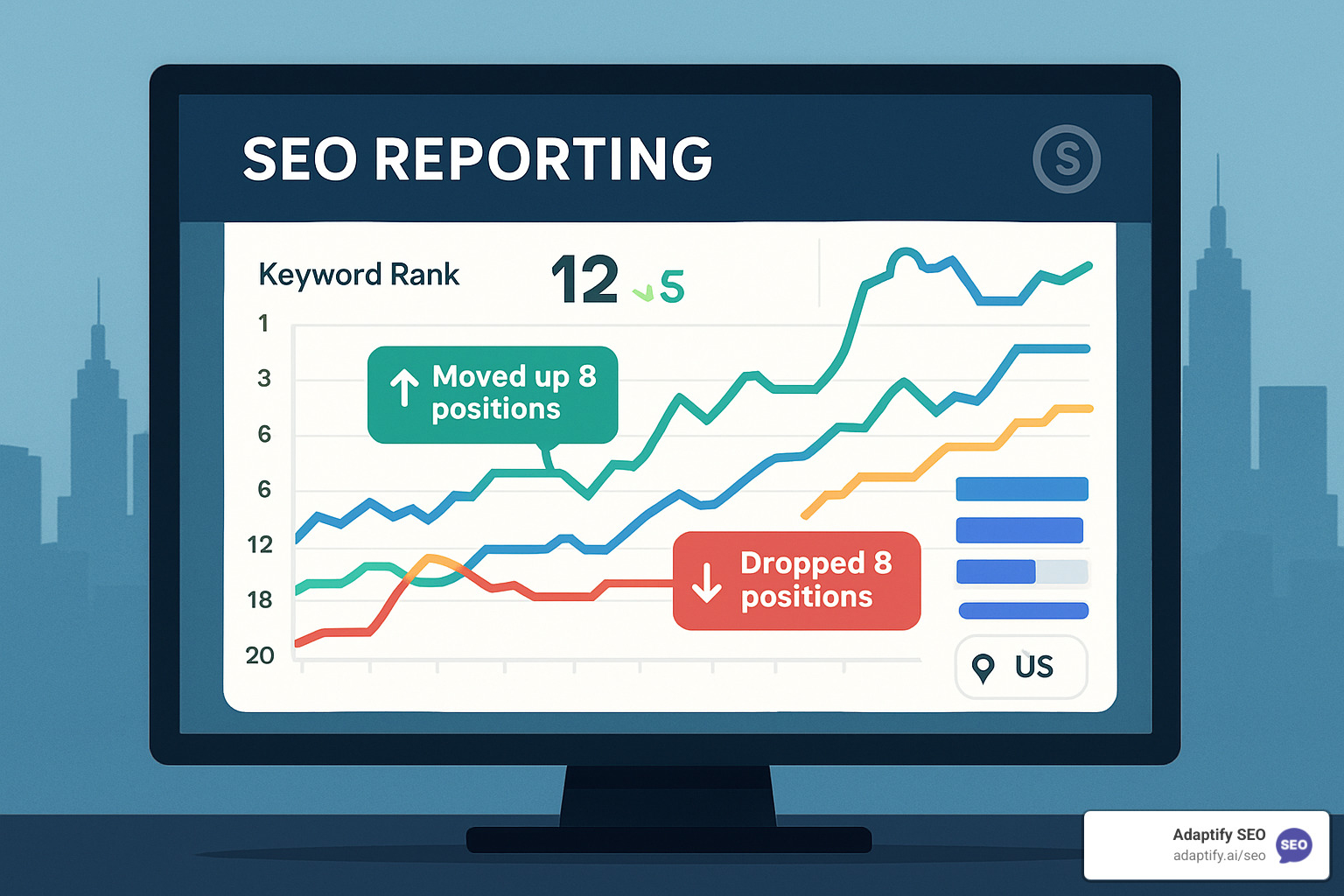
Interactive dashboards have transformed how we share SEO data. Rather than static reports that quickly become outdated, tools like SE Ranking offer living dashboards that stakeholders can explore. I've found that executives typically want high-level metrics like overall visibility scores and traffic trends, while SEO specialists need the nitty-gritty keyword movement data—and good dashboards can serve both audiences.
Sharing these insights has become wonderfully simple with shareable links. Instead of emailing bulky PDFs that clog inboxes, most modern rank tracking platforms generate secure URLs that recipients can access directly. This ensures everyone sees the freshest data and can interact with it.
For those who love connecting their data dots, integration with visualization tools like Looker Studio opens up exciting possibilities. You can combine ranking data with traffic numbers, conversion rates, and revenue figures to tell the complete story of your SEO impact. As AWR puts it, you can "leverage advanced reporting to maintain and improve keyword rankings, outrank competitors, and drive more visitors to your websites."
The most effective reports don't just show numbers—they tell stories. When you annotate ranking changes with notes about content updates, algorithm shifts, or competitor moves, you transform raw data into meaningful narrative that drives action.
Advanced Techniques to Turn Rank Data into Wins
Let's face it – collecting ranking data is just the starting point. The real magic happens when you transform those numbers into actionable insights that drive meaningful SEO improvements.
Smart SEO professionals use SEO Rank Monitoring to spot competitive gaps – those golden keywords where your competitors are thriving but you're nowhere to be found. These gaps aren't just data points; they're immediate opportunities for creating fresh content or revamping existing pages.
Have you heard about pixel tracking? Rather than simply noting that you're in position #3, tools like Nozzle measure exactly how many pixels from the top of the search results your listing appears. This matters because ads, featured snippets, and other SERP features can push that "#3 position" much further down the page than you'd expect.
"Understanding your true visibility in pixels gives you a much more accurate picture of your search presence than position numbers alone," explains one SEO director who switched to pixel-based tracking.
CTR forecasting takes your strategy to another level by combining your rankings with industry click-through rate patterns. This helps you estimate potential traffic from each keyword, letting you prioritize your efforts based on likely visitor gains rather than just moving up a position or two.
The most exciting development? AI-powered insights are changing how we interpret ranking data. Our own Adaptify.ai uses artificial intelligence to analyze ranking patterns and suggest specific optimization actions most likely to improve performance – taking the guesswork out of SEO strategy.
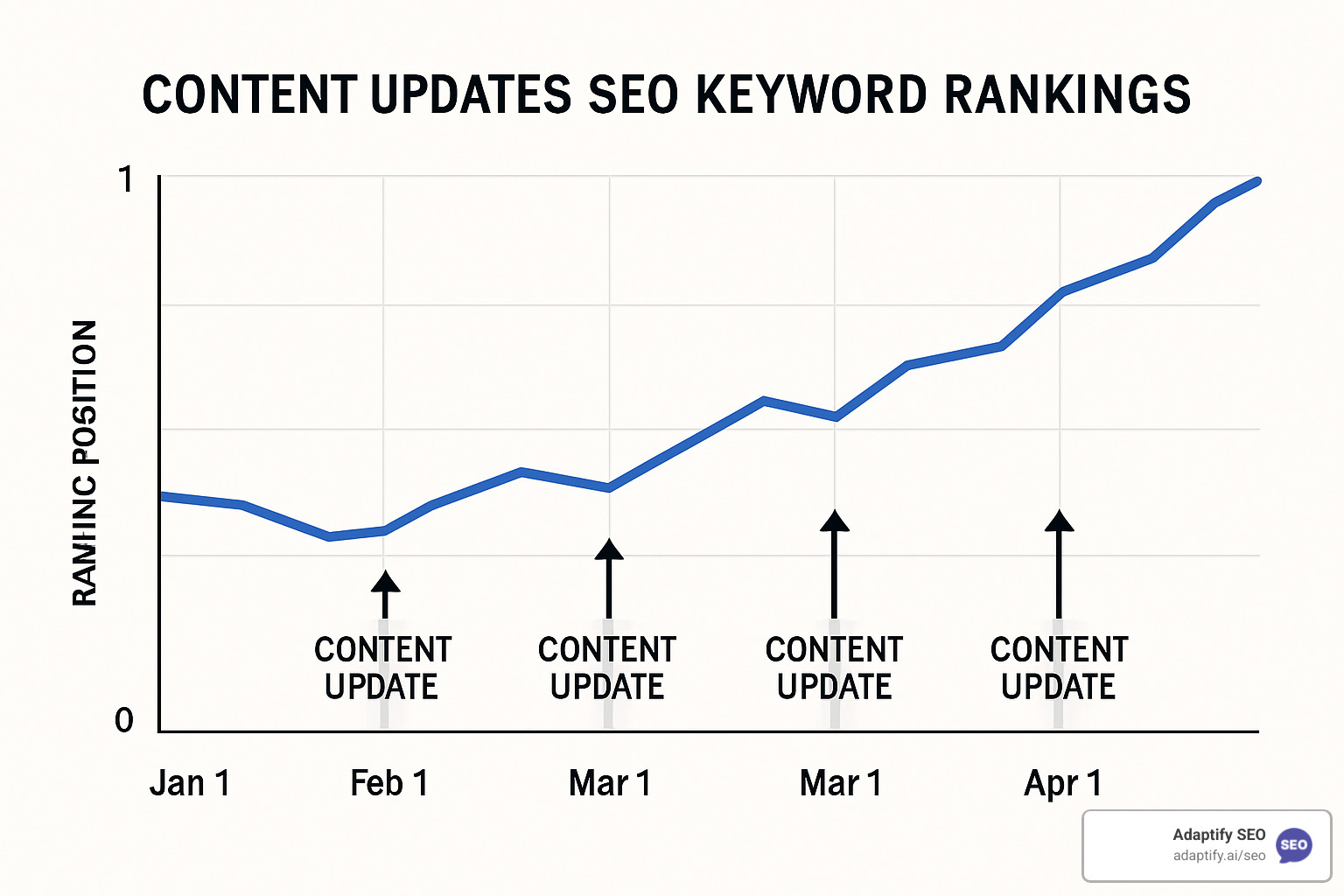
SEO Rank Monitoring for Competitor Analysis
One of the most valuable uses of SEO Rank Monitoring is peeking over the digital fence at your competitors. By tracking their rankings alongside yours, you'll uncover strategic insights that would otherwise remain hidden.
Market share analysis shows how your visibility stacks up against competitors across your entire keyword set. SE Ranking's massive database of 5.4 billion keywords and 2 billion domain profiles lets you see exactly where you stand in your market – whether you're the dominant player or have room to grow.
I love share of voice metrics because they measure what percentage of all possible impressions for your tracked keywords belong to you versus competitors. Instead of simply counting ranked keywords, you get a holistic view of your actual search presence.
SERP overlap analysis identifies keywords where both you and competitors appear on page one – these are your direct battlegrounds. A client once told me, "Finding these overlap keywords helped us focus our content efforts where small improvements directly took traffic from competitors."
My favorite advanced feature? Retroactive tracking. Tools like Nozzle let you add new competitors to your monitoring and "rewrite history" to see how they performed before you started tracking them. This gives you historical context without waiting months to collect fresh data.
"We finded a competitor had been steadily gaining ground for six months before we noticed them," shared one ecommerce manager. "Retroactive tracking helped us understand their strategy and respond appropriately."
Linking Rank Changes to On-Page & Off-Page Actions
The true power of SEO Rank Monitoring emerges when you connect ranking changes with specific SEO actions. This connection helps you determine which tactics actually move the needle for your site.
Content updates often trigger ranking shifts. When you publish new content or refresh existing pages, measuring the subsequent ranking impact tells you whether your content strategy is working. SE Ranking makes this easy by allowing you to set date-specific events to track alongside ranking data.
Backlink acquisition is another crucial element to monitor. When you secure that guest post or earn media coverage, tracking the ranking changes that follow helps quantify the impact of your link building efforts. Tools like Ahrefs combine backlink monitoring with rank tracking specifically for this purpose.
Technical fixes can dramatically influence rankings, though they're often overlooked. That page speed improvement, crawl error fix, or schema markup implementation might be the reason you jumped three positions. By documenting when these changes are made, you can attribute ranking improvements to specific technical work.
Some of our more data-savvy clients even use A/B testing approaches with their SEO Rank Monitoring. They'll implement changes on some pages but not others, then compare ranking trajectories to isolate the impact of specific optimization tactics.
"We finded that adding expert quotes to our content consistently improved rankings by an average of 2.3 positions," shared one content director. "We would never have known this without systematically tracking the connection between our actions and ranking changes."
Tools Comparison: Best SEO Rank Monitoring Platforms in 2025
The landscape of SEO Rank Monitoring tools has grown incredibly sophisticated in recent years. Gone are the days of simple position checkers – today's platforms offer powerful features that transform raw ranking data into actionable intelligence. When shopping for the right tool for your needs, here's what really matters:
Accuracy is non-negotiable – you need rankings that match what real users actually see when they search. Freshness matters too, as outdated data can lead to misguided decisions. The best tools provide comprehensive scope across desktop, mobile, and local rankings, while also tracking various SERP features like featured snippets and knowledge panels that impact visibility.
On the practical side, look for customizable reporting that communicates insights clearly to different stakeholders. Strong integrations with your existing marketing stack prevent data silos, and scalability ensures you can track your full keyword universe without breaking your budget.
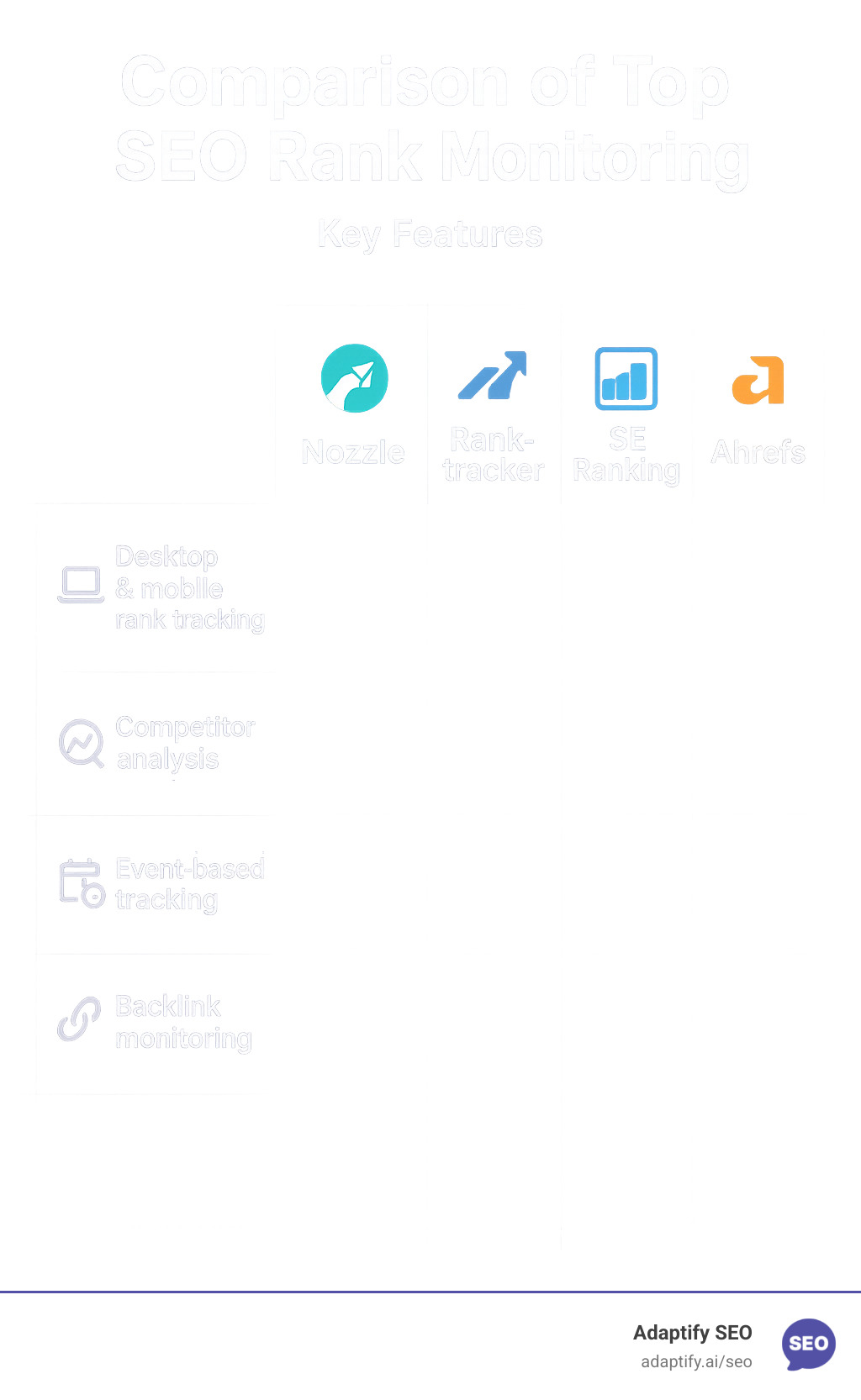
Cloud-Based Leaders
The cloud-based SEO Rank Monitoring space features several standout platforms that combine reliability with powerful features.
Advanced Web Ranking (AWR) brings over two decades of rank tracking expertise to the table, monitoring an impressive 48 million keywords across 4,000 search engines. What makes AWR particularly valuable for agencies is their unlimited approach – no caps on projects, users, or reports. Their pixel-level CTR analysis goes deeper than basic positions, showing you exactly how SERP features affect your true visibility.
Semrush's Position Tracking tool offers remarkable flexibility, letting you monitor any website, keyword, and location combination. With capacity for 5,000 keywords per project and daily updates, you can keep close tabs on up to 20 competitors simultaneously. The seamless integration with Semrush's broader SEO toolkit creates a natural workflow that many teams find invaluable.
SE Ranking has earned the trust of more than 40,000 companies by providing access to their massive 5.4 billion keyword database. Agencies particularly appreciate their white-label reporting and scheduled email updates, which streamline client communications. Their custom filtering options let you slice and dice data by search engine, website, date, or keyword groups to focus on what matters most.
All these platforms offer robust API access – a crucial feature for enterprises that need to pipe ranking data into broader business intelligence systems. This flexibility helps larger organizations connect the dots between SEO performance and business outcomes.
For a comprehensive comparison of the best rank tracking tools available today, check out Zapier's guide to the best rank tracking apps.
Flexible Data-Nerd Options
For the data enthusiasts and technical SEO specialists who need deeper customization, several platforms cater specifically to these more advanced needs.
Nozzle stands out with its unlimited brand footprint tracking that goes beyond just your main domain to include social profiles and unlimited domains. Their advanced metrics are a data analyst's dream – tracking pixels from top, above-the-fold percentage, and ad-adjusted rank. For teams with data science capabilities, their BigQuery exports open up endless possibilities for custom analysis.
ProRankTracker has built its reputation on accuracy and reliability over more than a decade in the rank tracking business. Their platform delivers daily on-demand rank updates across multiple search engines including Google, Bing, Yahoo, YouTube, and even Amazon. Their global coverage is particularly impressive, offering local tracking in any country and language, including Google Business Profile listings.
What makes these tools special is their focus on pixel-based metrics that tell the real story of visibility. As one happy Nozzle user put it: "In addition to Rank, track results by Pixels from Top, Above the Fold %, SERP % and more!" This matters because position #1 isn't always at the top of the page anymore – ads and SERP features can push it down where fewer users see it.
For organizations that need to perform custom analysis, these platforms offer extensive export options. Nozzle provides everything from simple CSV downloads to sophisticated SQL, API, and BigQuery exports, while ProRankTracker focuses on white-label automated reporting with multi-lingual support for global teams.
For an in-depth analysis of how to select the right SEO rank tracking tool for your specific needs, check out Search Engine Journal's comprehensive guide to selecting SEO rank tracking tools.
Common Pitfalls and How to Avoid Them
Let's be honest – even the most seasoned SEO pros sometimes trip up when it comes to SEO Rank Monitoring. I've seen it happen time and again, where smart marketers make simple mistakes that skew their data and lead them down the wrong path.
Sampling errors are probably the most common issue I encounter. Checking rankings manually once a week (or worse, once a month!) gives you a snapshot that might be completely unrepresentative. It's like judging the weather by looking outside for five seconds – you miss all the changes! Google's results fluctuate constantly, sometimes multiple times per day. The solution? Use automated tools that check rankings regularly and provide averaged results over time for a more accurate picture.
Personalization is another sneaky problem that can distort your view of rankings. Have you ever noticed how Google seems to know exactly what you're looking for? That's because it does! Search results vary based on your location, search history, and whether you're logged into your Google account. As one frustrated SEO manager told me, "I thought we were ranking #2 nationally until I realized I was just seeing personalized results!" To get around this, use rank tracking tools that disable personalization or add the &pws=0 parameter to Google URLs when checking manually.
Over-reporting is tempting but counterproductive. I've seen SEO teams bombard stakeholders with daily ranking updates for hundreds of keywords, only to have their reports ignored entirely. Information overload is real! Instead, create focused reports that highlight meaningful changes and actionable insights. Your CEO doesn't need to know that you dropped from position #7 to #8 for a low-volume keyword – but they absolutely should hear about significant movements in your money terms.
Many SEOs also miss the impact of SERP features on true visibility. Your page might technically rank #1 organically, but if the SERP has four ads, a featured snippet, and a local pack above it, your "top" result could be buried halfway down the screen. Tools like Nozzle that measure "pixels from top" give you a much more realistic view of where you actually appear in real-world searches.
SEO Rank Monitoring Mistakes to Dodge
Beyond those general pitfalls, there are some specific SEO Rank Monitoring mistakes that can really undermine your hard work.
Tracking the wrong location is a mistake I see constantly. If your business serves customers in Chicago, but you're tracking rankings as if you're in New York, your data simply won't reflect what your actual customers see. This is especially critical for local businesses – rankings can vary dramatically even between neighboring zip codes. Most professional rank tracking tools allow you to specify precise locations down to the city or postal code level, so take advantage of this feature!
Mobile blindspots happen when teams focus exclusively on desktop rankings despite the fact that most searches now happen on mobile devices. With Google's mobile-first indexing, mobile rankings often predict future desktop rankings anyway. I always recommend monitoring both device types to get the complete picture – and if you have to choose just one, choose mobile.
KPI silos develop when ranking data isn't connected to other metrics like traffic, engagement, and conversions. Rankings alone don't tell the full story – a #1 ranking for a low-intent keyword might drive less business value than a #3 ranking for a high-converting term. I've worked with clients who celebrated reaching #1 for their target keyword, only to find it brought no meaningful traffic! Integrate your rank tracking with analytics platforms to see the correlation between rankings and actual business outcomes.
Neglecting historical context makes it impossible to identify trends and seasonal patterns. Without historical data, you might panic over a ranking drop that's actually just a normal seasonal fluctuation. Ahrefs' Keyword Rank Checker provides historical ranking data back to 2015, allowing you to identify long-term trends and cyclical patterns that might otherwise be misinterpreted as permanent changes.
"We've been doing rank tracking for over 20 years and if we weren't reliable, we wouldn't be here," notes AWR, highlighting something important – reliability matters. Choose established, proven tools for your monitoring rather than the newest shiny object that might disappear next year.
SEO Rank Monitoring is meant to provide clarity, not confusion. When you avoid these common pitfalls, your ranking data becomes a powerful compass guiding your SEO strategy, rather than a source of misleading signals.
Frequently Asked Questions about SEO Rank Monitoring
How often should I update keyword rankings?
Finding the right frequency for your SEO Rank Monitoring updates is a bit like deciding how often to check your investments—it depends on what you've got at stake and what you're trying to achieve.
For most websites, daily rank checks provide the sweet spot between staying informed and not becoming obsessed. As one SEO expert put it, "Daily reports help you identify opportunities faster without falling into the trap of checking rankings every hour."
Your ideal frequency might vary based on a few key factors:
If you're in a highly competitive industry like finance or healthcare, daily updates help you stay on top of even the smallest shifts. For less competitive niches, weekly checks might give you all the insights you need.
Your content publication rhythm matters too. If you're publishing new content every day, you'll want to track rankings daily to see how those fresh pages perform. For sites that publish monthly, less frequent checks might suffice.
During Google's algorithm updates (those exciting times when SEO professionals don't sleep!), you'll definitely want daily—sometimes even more frequent—updates to understand how the changes affect your site.
Budget considerations play a role too. More frequent checks typically cost more with most rank tracking platforms, so you'll need to balance data freshness with what makes financial sense.
Tools like Ranktracker offer flexible scheduling that lets you monitor your most important keywords daily while checking secondary terms weekly or monthly. For truly business-critical keywords during major campaigns, some advanced platforms like Nozzle can even check rankings as frequently as every 5 minutes—though that's rarely necessary for most businesses.
How do rank trackers ensure data accuracy?
Getting accurate ranking data is surprisingly tricky—like trying to measure something that doesn't want to be measured. Google and other search engines aren't exactly fans of automated rank checking (they'd prefer you focus on users rather than rankings).
The best SEO Rank Monitoring tools use some clever techniques to deliver accurate results:
They employ massive networks of rotating proxies—Ranktracker, for instance, uses over 20 million different IP addresses to avoid being detected or blocked by search engines. It's like having millions of different people checking your rankings rather than just one person.
Good rank trackers don't just grab raw data; they mimic real human browsing behavior. They load pages like actual Chrome or Safari browsers would, complete with realistic user agents and rendering engines that make them appear as regular users to Google.
Personalization is another challenge they overcome. When you search Google yourself, your results are custom based on your history and preferences. Quality rank trackers strip away this personalization by adding special parameters to search queries (like &pws=0) that tell Google to show standard results.
For local rankings, they use specialized servers or proxies physically located in your target areas. If you need to know how you rank in Chicago, the tool will check from Chicago—not from their headquarters in another country.
The most reliable platforms don't just check each ranking once; they take multiple measurements from different IPs and average the results. This helps filter out temporary fluctuations or anomalies.
As one provider candidly explained, "No rank tracker is perfect—Google's results naturally vary slightly based on numerous factors. But with our advanced methods, we get as close to the truth as technically possible."
What's the difference between organic position and pixel position?
This distinction represents one of the most important evolutions in modern SEO Rank Monitoring—and understanding it can completely change how you evaluate your search success.
Organic position is the traditional way we've all talked about rankings: "We're #1 for this keyword!" or "We moved up from position 5 to position 3!" It's your numerical placement in the organic search results, not counting ads.
Pixel position, on the other hand, measures exactly how many pixels from the top of the search results page your listing appears. This newer metric recognizes a fundamental truth about modern search: being "#1" doesn't mean you're actually at the top of the page anymore.
Think about the last time you searched for something like "hotels in Chicago" or "best wireless headphones." Before you saw a single organic result, you probably encountered:
- Several ads (sometimes taking up the entire screen)
- A local map pack with nearby businesses
- Shopping results with product images
- Perhaps a featured snippet answering a common question
- Maybe even images, videos, or other special features
All these elements push the "#1 organic position" further down the page—sometimes so far that users need to scroll quite a bit to see it.
That's why tools like Nozzle have pioneered pixel tracking, offering metrics like "Pixels from Top" and "Above the Fold %." As they explain, "In addition to Rank, track results by Pixels from Top, Above the Fold %, SERP % and more!"
This approach gives you a much more realistic picture of your actual visibility. Your site might rank #1 organically but appear 1,200 pixels down the page (where fewer people will see it). Conversely, a #3 ranking with no SERP features above it might be more visible than a #1 ranking buried beneath ads and features.
Pixel position aligns more closely with the actual user experience and provides a more honest assessment of whether searchers are likely to see—and click on—your result.
Conclusion
Effective SEO Rank Monitoring is no longer just a nice-to-have for businesses serious about digital marketing – it's become absolutely essential for anyone who wants to succeed online.
Throughout this guide, we've seen how modern rank tracking has evolved far beyond the simplistic "am I #1 for this keyword?" approach. Today's sophisticated monitoring paints a complete picture of your search visibility across desktop, mobile, and local searches. It tracks how SERP features affect your visibility, measures your position down to the pixel level, and connects your rankings to actual business outcomes that matter.
When you implement a thoughtful SEO Rank Monitoring framework, you open up powerful capabilities that transform your approach:
You can finally see which content updates and optimization efforts are actually moving the needle on rankings. You'll find untapped keyword opportunities by analyzing competitive gaps. Most importantly, you'll be able to demonstrate the real business impact of your SEO investments to stakeholders who care about results, not rankings.
With proper monitoring in place, you'll quickly detect and respond to algorithm updates or competitor moves before they become problems. And perhaps most valuable of all – you'll make smarter, data-backed decisions about where to focus your SEO efforts next.
At Adaptify.ai, we've built our automated SEO services around these principles – streamlining everything from finding ranking opportunities to implementing the content and technical changes that actually improve positions. Our AI-powered approach drastically reduces the manual grunt work while enhancing the precision and effectiveness of your SEO campaigns.
Let's be honest – search is constantly evolving. New SERP features appear regularly, algorithm updates drop without warning, and competitors are always working to outrank you. Robust SEO Rank Monitoring gives you the visibility and insights needed to steer this complexity and consistently improve your search performance over time.
Ready to transform how you track and improve your keyword rankings? Book a Demo to see how Adaptify.ai's automated SEO solutions can streamline your rank monitoring and turn all that data into actionable growth strategies that actually deliver results.
